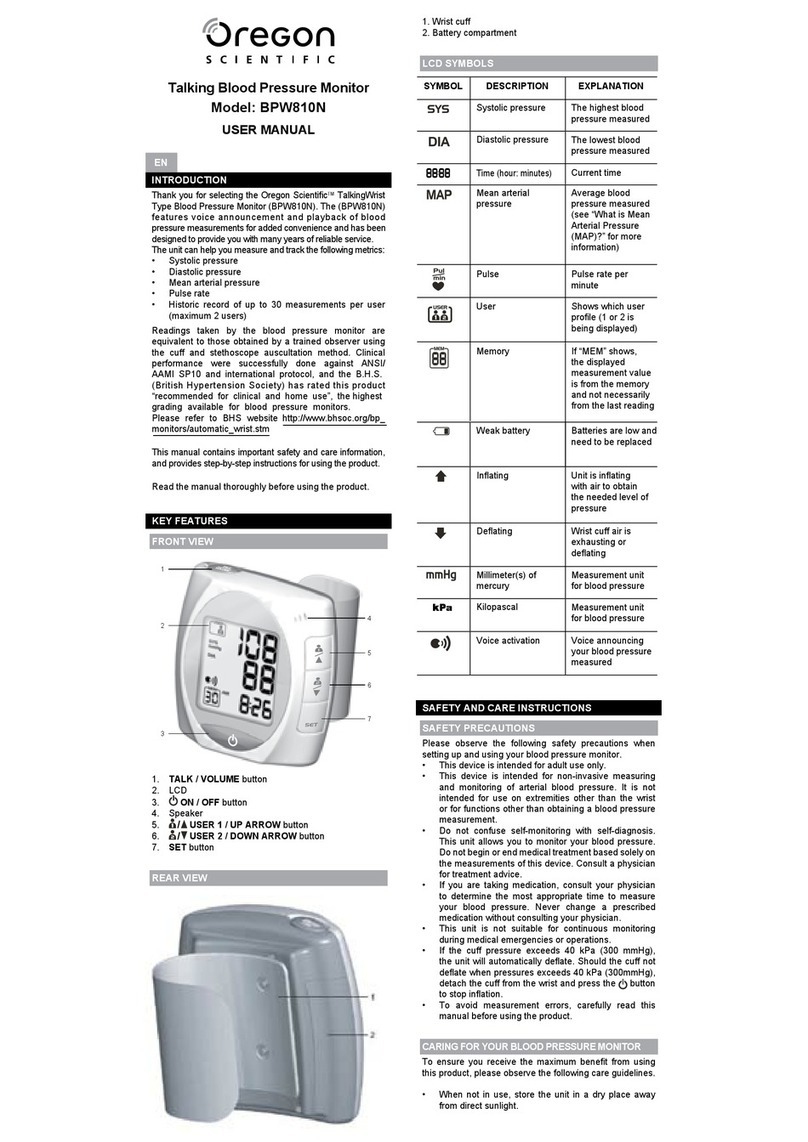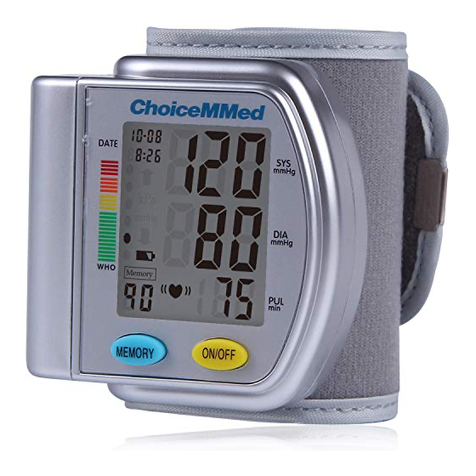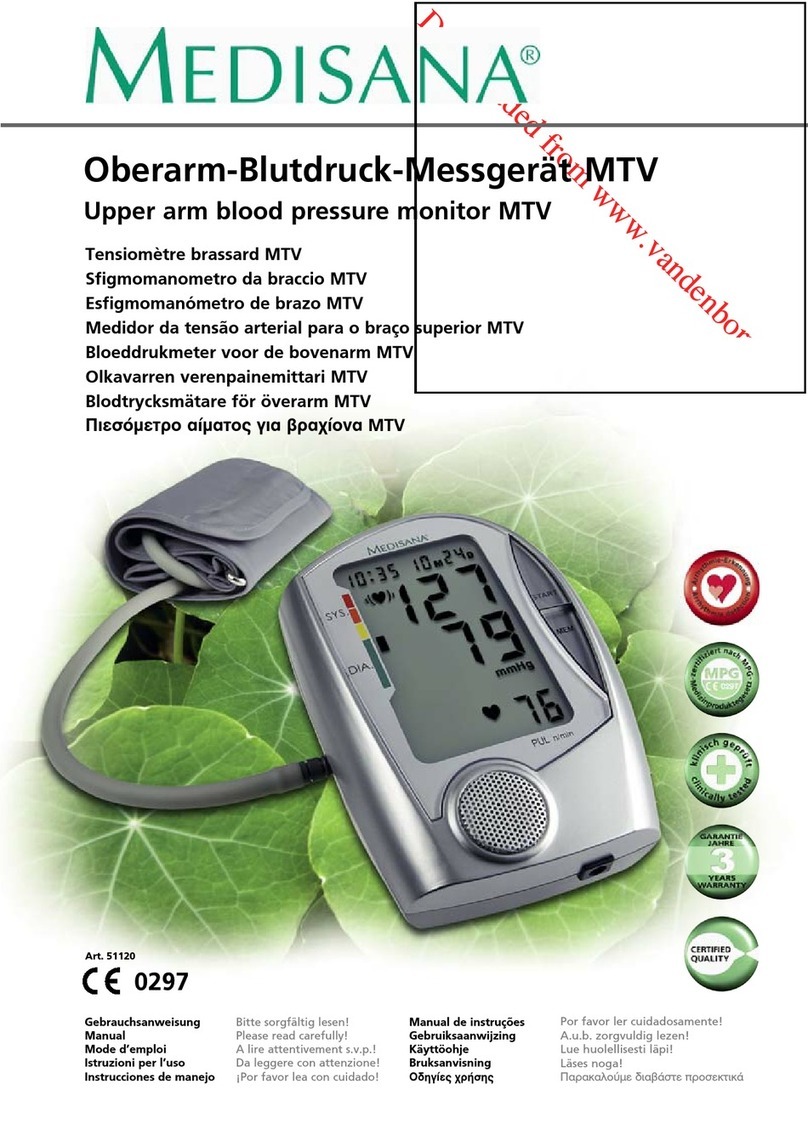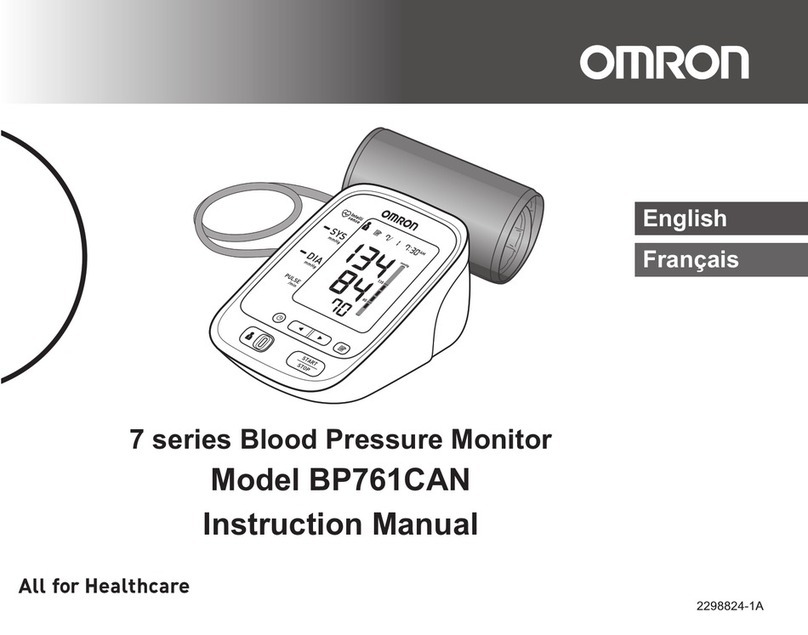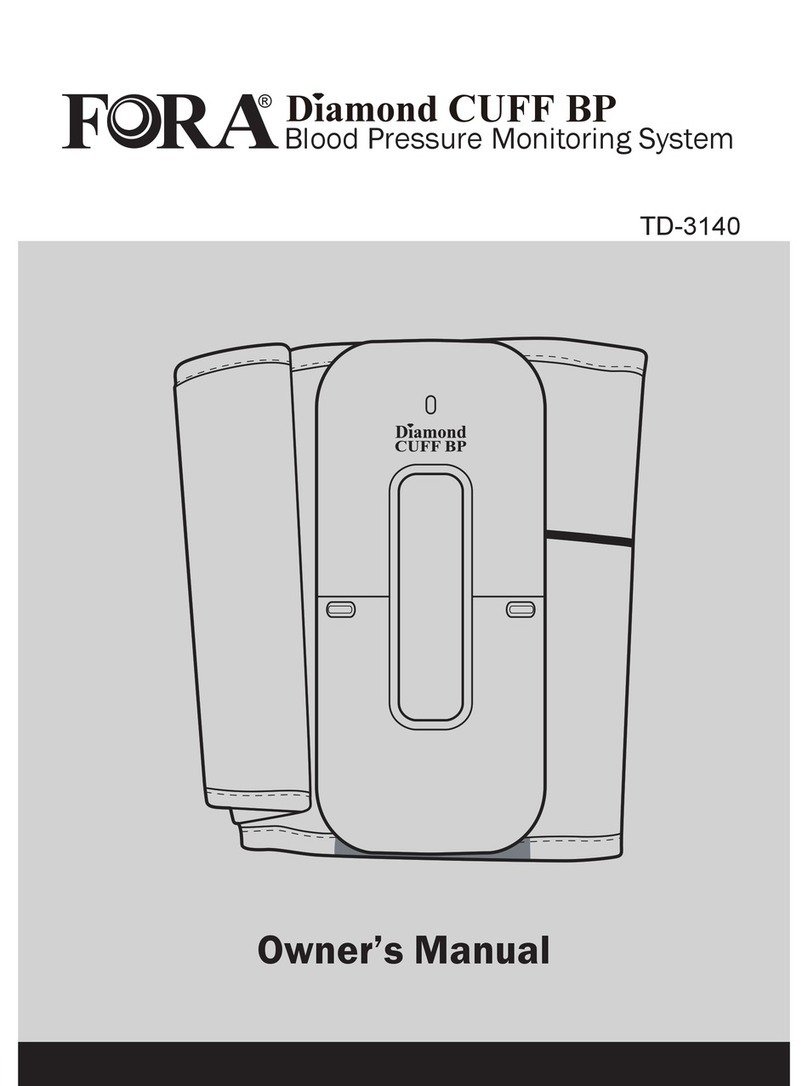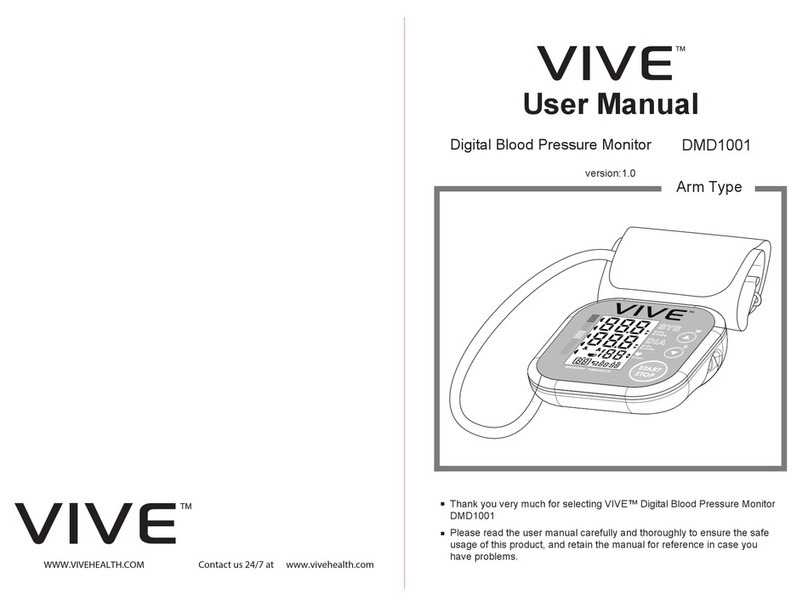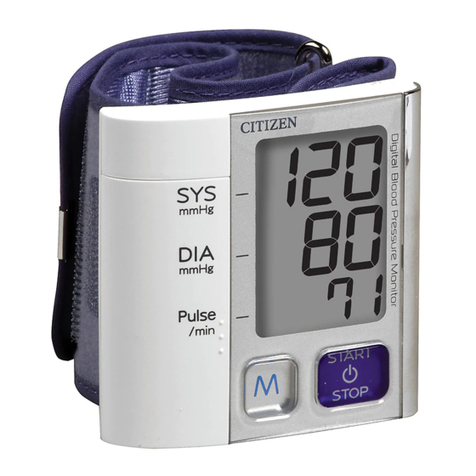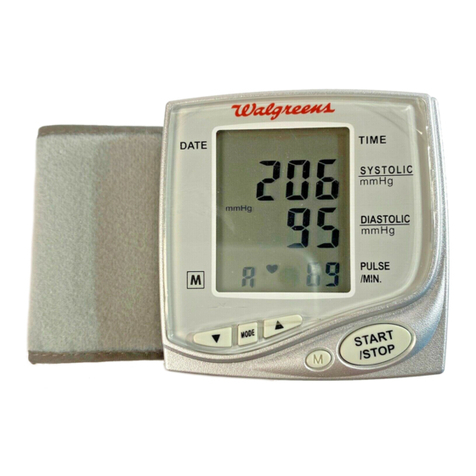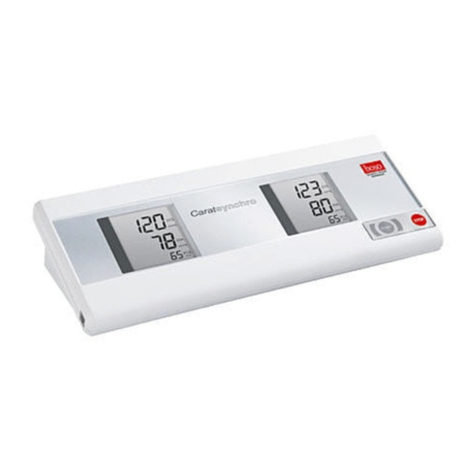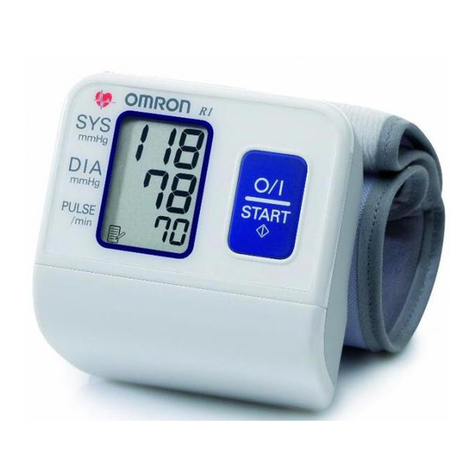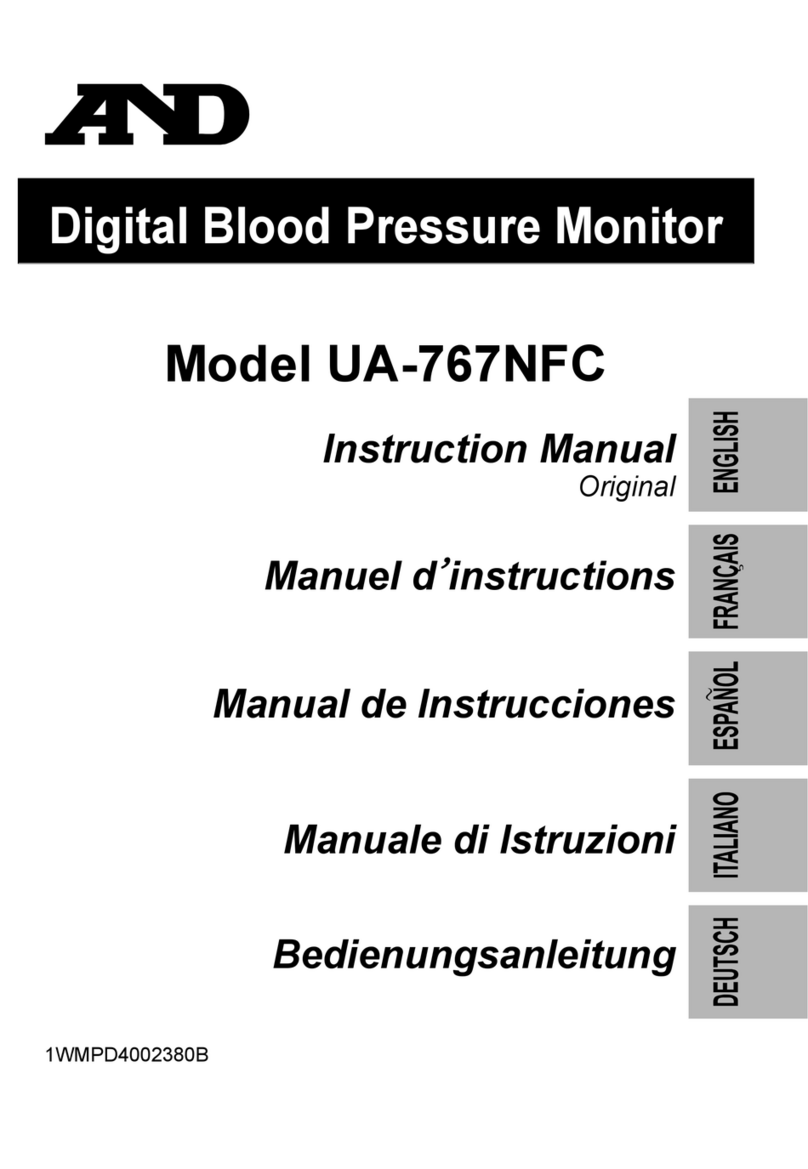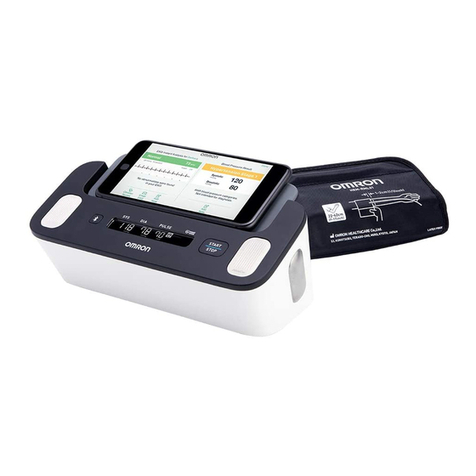Oregon Scientific BPW810N User manual

EN
Talking Blood Pressure Monitor
Model:
BPW810N
USER MANUAL
INTRODUCTION
Thank you for selecting the Oregon Scientifi c
TM
Thank you for selecting the Oregon Scientifi cTM
Thank you for selecting the Oregon Scientifi c
TalkingWrist
Type Blood Pressure Monitor. The features voice
announcement and playback of blood pressure measurements
for added convenience and has been designed to provide you
with many years of reliable service. The unit can help you
measure and track the following metrics:
• Systolic pressure
• Diastolic pressure
• Mean arterial pressure
• Pulse rate
•
Historic record of up to 30 measurements per user
(maximum 2 users)
Readings taken by the blood pressure monitor are
equivalent to those obtained by a trained observer using
the cuff and stethoscope auscultation method. Clinical
performance were successfully done against ANSI/
AAMI SP10 and international protocol, and the B.H.S.(
British Hypertension Society) has rated this product
“recommended for clinical and home use”, this is the
highest grading available for blood pressure monitors.
please refer to BHS website
http://www.bhsoc.org/bp_
monitors/automatic_wrist.stm
This manual contains important safety and care
information,
and provides step-by-step instructions for using the product.
Read the manual thoroughly before using the product.
KEY FEATURES
FRONT VIEW
1.
TALK / VOLUME
button
2. LCD
3.
ON / OFF
button
4. Speaker
5.
USER 1 / UP ARROW
button
6.
USER 2 / DOWN ARROW
button
7.
SET
button
REAR VIEW
1
2
3
5
4
6
7
2
1
1. Wrist cuff
2. Battery compartment
LCD SYMBOLS
SAFETY AND CARE INSTRUCTIONS
SAFETY PRECAUTIONS
Please observe the following safety precautions when
setting up and using your blood pressure monitor.
• This device is intended for adult use only.
• This device is intended for non-invasive measuring
and monitoring of arterial blood pressure. It is not
intended for use on extremities other than the wrist
or for functions other than obtaining a blood pressure
measurement.
• Do not confuse self-monitoring with self-diagnosis.
This unit allows you to monitor your blood pressure.
Do not begin or end medical treatment based solely on
the measurements of this device. Consult a physician
for treatment advice.
• If you are taking medication, consult your physician
to determine the most appropriate time to measure
your blood pressure. Never change a prescribed
medication without consulting your physician.
• This unit is not suitable for continuous monitoring
during medical emergencies or operations.
• If the cuff pressure exceeds 40 kPa (300 mmHg),
the unit will automatically defl ate. Should the cuff not
defl ate when pressures exceeds 40 kPa (300mmHg),
detach the cuff from the wrist and press the
button
to stop infl ation.
• To avoid measurement errors, carefully read this
manual before using the product.
CARING FOR YOUR BLOOD PRESSURE MONITOR
To ensure you receive the maximum benefi t from using
this product, please observe the following care guidelines.
• When not in use, store the unit in a dry place away
from direct sunlight.
User
Shows which user
profi le (1 or 2 is
being displayed)
Memory
If “MEM” shows,
the displayed
measurement value
is from the memory
and not necessarily
from the last reading
SYMBOL
DESCRIPTION
EXPLANATION
Systolic pressure
The highest blood
pressure measured
Diastolic pressure
The lowest blood
pressure measured
Time (hour: minutes)
Current time
Mean arterial
pressure
Average blood
pressure measured
(see “What is Mean
Arterial Pressure
(MAP)?” for more
information)
Pulse
Pulse rate per
minute
Weak battery
Batteries are low and
need to be replaced
Infl ating
Unit is infl ating
with air to obtain
the needed level of
pressure
Defl ating
Wrist cuff air is
exhausting or
defl ating
Millimeter(s) of
mercury
Measurement unit
for blood pressure
Kilopascal
Measurement unit
for blood pressure
Voice activation
Voice announcing
your blood pressure
measured
• Do not immerse the unit in water. If it comes in contact
with water, dry it immediately with a soft lint-free cloth.
• Use a soft, slightly moistened cloth to wipe off the unit
and cuff. Do not use abrasive or corrosive cleaning
agents, as these may cause damage.
• Remove the batteries whenever you are planning to
store the unit for a long period of time.
• When replacing batteries, use new batteries as
specifi ed in this user manual. Do not mix new and old
batteries.
• Do not place objects such as stickers on the wrist cuff
or unit, as these may impair the measurement.
• Do not subject the unit to excessive force, shock, dust,
temperature changes, or humidity. Such treatment
may result in malfunction, a shorter electronic life
span, damaged batteries, or distorted parts.
• Do not tamper with the internal components. Doing
so will terminate the product warranty and may cause
damage.
• The unit contains no user- serviceable parts.
• If you no longer need to use this product, protect the
environment by bringing it to your dealer or designated
collection point for proper disposal.
ABOUT BLOOD PRESSURE
What is blood pressure?
Blood pressure is the force generated by the blood against the
walls of arteries during cardiac contraction and relaxation
(e.g., the pumping action of the heart).
What are systolic pressure and diastolic pressure?
When ventricles contract and pump blood out of the heart,
blood pressure reaches its maximum value. This highest
pressure in the cycle is known as systolic pressure. When
the heart relaxes between heartbeats, the lowest blood
pressure is diastolic pressure.
What is mean arterial pressure (MAP)?
The mean arterial pressure (MAP) is the average
pressure that forces blood through the arteries. It is not
the average of the systolic and diastolic blood pressure;
rather, MAP corresponds to a state of balance between the
compressive and expansive forces acting on the arterial
wall when there is no distension outward or inward. MAP is
an excellent way to evaluate the stress on the walls of your
blood vessels, and can be used to evaluate excessive load
on the cardiovascular system. Show your MAP history to
your doctor to provide additional information that may help
him or her understand your situation.
Why measure your blood pressure?
Blood pressure measurement can highly refl ect one’s
health condition. High blood pressure is potentially linked
to serious illnesses such as stroke, heart disease and
kidney failure.
Since there is no symptom most of the time, many
hypertensive people do not realize they are at risk until
their health is seriously threatened.
What is the standard blood pressure classifi cation?
Figure 3 illustrates the blood Pressure classifi cation made
by World Health Organization (WHO) and International
Society of Hypertension (ISH) in 1999.
Reference material:° 1999 World Health Organization-
International Society of Hypertension Guidelines for the
management of hypertension, Journal of Hypertension,
1999, 17(2): 151-183.
NOTE
• Blood pressure is considered high when either the
diastolic or systolic blood pressure value exceeds the
normal range. When a patient s systolic and diastolic
blood pressures fall into different categories, the
higher category should apply.
• Only a physician can tell you your normal blood
pressure range and the point at which you are at risk.
Consult your physician to obtain these values. If the
measurements taken with these products fall outside
the range, consult your physician.
Why does my blood pressure fl uctuate throughout the day?
Individual blood pressure varies greatly both on a daily and
a seasonal or temperature basis. These variations may be
more pronounced in hypertensive patients. Normally the
blood pressure rises while at work and is at its lowest
during sleep.
The graph below illustrates the variations over a single day
with measurement taken every 5 minutes. The thick line
represents sleep time. The rises in blood pressure at 4PM
(A in the graph) and 12AM (Bin the graph) correspond to
an attack of pain and sexual intercourse (Beven, Honour &
Stott, Clin. Sci. 36:329, 1969).
HOW THE BLOOD PRESSURE MONITOR WORKS
This product uses the Oscillometric Measuring method to
detect your blood pressure. Before every measurement,
the unit establishes a “zero pressure”equivalent to the air
pressure.
Then it starts infl ating the wrist cuff to 180mmHg or higher
until it senses that it has blocked your blood in the artery.
After that, the defl ation process starts, during which time
the unit detects pressure oscillations generated by beat-
to-beat pulsatile, which is used to determine the systolic,
mean and diastolic pressure, and also your pulse rate.
Any motion during this period will result in an incorrect
measurement. After all readings are determined and
displayed on the LCD, the measurement is fi nished and
the wrist cuff automatically defl ates.
GETTING STARTED
INSTALLING AND REPLACING THE BATTERIES
1. Slide off the battery cover.
2. Install the batteries by matching the correct polarity, as
shown below. Always use the correct battery type (2
alkaline LR03 AAA-size).
3. Replace the cover.
NOTE
Replace the batteries whenever the weak battery
mark
shows, the display is dim, or the display does not
illuminate when the power is on. Replace all the batteries
at the same time - it is dangerous to mix old and new
batteries.
Contact your local waste disposal authority for instructions
on how to dispose of used batteries. Used batteries can be
harmful to the environment, and should not be thrown out
with household trash.
SETTING DATE, TIME AND MEASUREMENT NITS
It is important to set the clock before using your blood
pressure monitor, so that a time stamp can be assigned to
each record that is stored in the memory.
1. When the unit is off, press and hold
SET
for 2 seconds
to enter the setting mode.
2. The setting order is as follows: 12/24 hour format,
hour, minute, year, month/day or day / month format,
month, date, and measurement unit (kPa or mmHg).
3. Press
or
or
to increase / decrease a value or change the
to increase / decrease a value or change the
setting.
4. Press
SET
to accept the change and switch to the next
setting.
5. When you are fi nished, press
to exit the setup menu.
to exit the setup menu.
POSITIONING THE WRIST CUFF
It is important to properly position the wrist cuff to ensure
that you receive an accurate reading.
1. Remove all accessories (watch, bracelet, etc.) from
your left wrist. If your physician has diagnosed you with
poor circulation in your left arm, use your right wrist.
2. Roll or push up your sleeve to expose the skin.
3. Apply the cuff to your left wrist with your palm facing up.
4. Position the edge of the cuff about 0.4 inches (1cm)
from the bottom of your palm.
5. Fasten the wrist cuff around your wrist, leaving no
extra room between the cuff and your skin. If the cuff
is too loose, the measurement will not be accurate.
NOTE
Graphics may not exactly match product.
VOICE PLAYBACK OF BLOOD PRESSURE
MEASUREMENTS
The features voice playback during and after blood
pressure measurement results, as well as general
instructions to help you prepare for taking measurements.
When the unit has fi nished taking your measurement,
your blood pressure readings, pulse and blood pressure
classifi cation are announced.
If you want to repeat the announcement, simply press
TALK / VOLUME.
Anytime you recall a measurement record from memory,
it will also be announced. Press
TALK / VOLUME
if you
need to repeat the playback of any record.
VOLUME CONTROL
To adjust the volume level:
1. Press and hold
TALK / VOLUME
until volume level
fl ashes on the LCD.
2. Press
TALK / VOLUME
to adjust volume level.
3. Press
when you have fi nished adjusting the volume.
when you have fi nished adjusting the volume.
NOTE
When volume level 0 is selected, the unit is on mute
and you will not hear any voice messages announced.
TAKING A BLOOD PRESSURE MEASUREMENT
You can choose to take your blood pressure while sitting or lying
down. Below are some helpful tips for taking a measurement:
• Be sure to set the clock before taking your fi rst
measurement, or whenever you replace the batteries,
so that the date and time are stored in the memory
with your history. For instructions, refer to p. 6.
• It is important to relax when taking your blood pressure.
Try to take a 15-minute rest before you begin.
• Do not lean backward or bend your wrist inward while
taking a measurement.
• Avoid talking or moving your fi ngers and hand while
taking a measurement. Rapid movements or other
0
1
2
(MUTE)
(VOLUME IS
LOW)
(VOLUME IS
HIGH
)
kP
a
Grade 3 hypertension(severe)
Grade 2 hypertension(moderate)
Systolic blood pressure (mmHg)
Grade 1 hypertension(mild)
Subgroup: borderline
High-normal Blood Pressure
)g
Hmm(eru
ss
e
rp
do
olb
c
i
l
o
t
sa
iD
Normal Blood Pressure
Optimal Blood
Pressure
120
80
85
90
95
100
110
130 140 150 160 180
BPW810N_M_R3.indd 1 10/17/07 2:53:30 PM
P/N: 086L004064-051 REV1
1/2

activities may alter your reading.
• Wait at least an hour before taking your blood pressure
if you have just eaten a large meal.
• Do not smoke or drink alcohol before taking your blood
pressure.
• Do not measure your blood pressure if you are under stress.
• Wait at least 3 minutes between measurements. This
allows your blood circulation to recover.
• For a meaningful comparison, try to measure under
similar conditions. For example, take daily measurements
at approximately the same time, on the same wrist, or as
directed by a physician.
• To stop the measurement process at any time, press
.
• The unit automatically switches off 1 minute after
taking a measurement. To save the battery life, press
taking a measurement. To save the battery life, press
as soon as you are fi nished to turn off the unit.
To take a measurement:
1. Choose the position you from which you wish to
measure - sitting or lying down.
2. Position your body so that your wrist is parallel with your
heart, using the chart and illustrations below as a guide.
3. Relax your hand and press to turn on the unit. A voice
message will remind you to relax and remain still. It then
begins infl ating the wrist cuff. Once the pressure reaches
180 mmHg, it will slowly defl ateuntil the meas urement
results show on the LCD.
NOTE
This unit can intelligently adjust the cuff pressure
and infl ate to a higher-pressure level (>180 mmHg) when
needed.
Your systolic and diastolic pressure readings fl ash on the
LCD, followed by MAP and pulse per minute readings
every 2 seconds. At the same time, your measurement
results and the blood pressure classifi cation will also be
announced.
4. To repeat the announcement, simply press
TALK /
VOLUME.
5. If you want to save the record to memory, press
or
or
and the results will be saved to User 1’s or User 2’s
and the results will be saved to User 1’s or User 2’s
memory accordingly.
The measurement is stored as the fi rst (MEM 1) entry in
the user record you selected; the last entry (MEM 30) is
dropped, and all the entries in between move up 1 digit
(e.g. 28 becomes 29, and so on).
Sitting
down
with no
armrest
Place your arm across your chest with
the wrist parallel to your heart. Hold your
elbow with the other hand.
Position your wrist on a support, cushion,
or your thigh so that it is parallel with your
heart with the palm facing up.
Lying
down
IF YOU
ARE...
Sitting
down
with an
armrest
Place your elbow on a table, using an object
as a support under your forearm. Your wrist
should be parallel with your heart with the
palm facing up.
THEN...
RECALLING MEASUREMENTS STORED IN MEMORY
To view a history of User 1’s records, press
.
To view a history of User 2’s records, press
.
NOTE
• The most recent record (1) is shown fi rst. Each new
measurement is assigned to the fi rst (1) record. All other
records are pushed back one digit (e.g., 2 becomes 3, and
so on), and the last record (30) is dropped from the list.
• Press the corresponding user button again (
or
or
)
)
to see additional records.
• Press and hold the corresponding user button to auto-
advance to additional records.
• The date and time of measurement are shown with
each record.
• Memory records will be kept even when the batteries
become exhausted and are replaced.
DELETING A MEASUREMENT RECORD FROM MEMORY
You have the option of deleting your latest measurement
record or entire measurement history. This is useful if
measurements have not been accurately recorded and
need to be recorded again.
DELETING THE LATEST RECORD
1. Press
or
to recall the latest measurement
record for User 1 or User 2.
2. Press and hold SET until the LCD shows “dEL ONE”.
3. Press and hold SET for 2 seconds to delete the latest
recorded measurement for User 1 or User 2. After you
have confi rmed deleting the latest record, the screen
shows dEL dONE.
4. If you decide to abort the delete action instead, press
to go back to the main screen.
DELETING ALL RECORDS
1. Press
or
to recall the latest measurement
record for User 1 or User 2.
2. Press and hold SET until the LCD shows “dEL ONE”.
3. Press
to show the option of deleting your entire
measurement history; the LCD displays “DEL ALL”.
4. Press and hold SET for 2 seconds to delete all
measurement records. After you have confi rmed
deleting all records, the screen shows dEL dONe.
5. If you decide to abort the delete action instead, press
once OR press
twice to go back to the main
screen.
Problem
Symptom
C
heck
Thi
s R
emed
y
s R
No
powe
r
Display is
dim or will
not light up
Batteries ar
e
exhauste
d
Replace with
new batterie
s
Batteries ar
e
inserted
incorrectl
y
Insert th
e
batteries
correctly
Lo
w
batteries
batteries
show
s
on th
on th
e
e
displa
y
Batteries
are low
are low
Replac
e
with ne
with ne
w
w
batteries
TROUBLESHOOTING
This section includes a list of error messages and frequently
asked questions for problems you may encounter with your
blood pressure monitor. If the product is not operating as you
think it should, check here before arranging for servicing.
TECHNICAL SPECIFICATIONS
Application:
Measuring method
Oscillometric / noninvasive
Application
For adult use only
Measurement location Wrist section of lower arm
Memory
Maximum 30 records
per user
Maximum number of users
2
Dimensions:
Height x Width x Depth
3.5 x 3.4 x 1.2 inches
(90 x 86 x 30.8 mm)
Weight
6.3 oz (180g) without batteries
Cuff circumference
5.3 to 7.7 inches (13.5
to 19.5 cm)
Measuring range:
Pressur 30 to 280 mmHg
(4.0 to 37.3 kPa)
Pulse 40 to 200 pulse/min
Accuracy:
Pressure +/- 3 mmHg (+/- 0.4 kPa)
Pulse +/- 5%
Power:
Power supply
3V DC, 2 LR03 / AAA /
UM4-size 1.5V batteries
Power save
Auto power off after 1
minute of non-activity
Operating environment:
Operation 50°F to 104°F (10°C to 40°C)
Storage / Transport -4°F to 140°F (-20°C to 60°C)
Humidity range 10% to 83% relative humidity
INFORMATION ABOUT THE CE MARK
This device complies with the European regulations based
on the Medical Products Code, and bears the CE mark
“CE0120”. The device has been quality inspected according
to EU guideline 93/42/EEC and tested in compliance to
the “EN1060-1 Non-invasive sphygmomanometers - Part
1, General requirements” and “EN1060-3 Non-invasive
sphygmomanometers- Part3: Supplementary requirements
for electromechanical blood pressure measuring systems”.
The CE mark further indicates that this blood pressure monitor
meets the general requirements for electronic products
as regards to resistance to electromagnetic interference.
Malfunctioning may however occur in the proximity of
extremely strong electromagnetic fi elds. In accordance
with the “Ordinance for Operators of Medical Products”, a
technical inspection must be carried out if this device is used
for industrial or commercial purposes.
BLOOD PRESSURE LOG BOOK
To create a log of your blood pressure history, complete the
personal information section at the top, then enter the details
(date, time, and measurements) for each reading you take.
To plot your history, use an S (systolic), D (diastolic) and
M (mean arterial pressure) to mark the points where each
measurement falls on the chart, then connect the points to
view your history over time.
Name: Age: Weight: (kg/lbs)
Name: Age: Weight: (kg/lbs)
Name: Age: Weight: (kg/lbs)
Name: Age: Weight: (kg/lbs)
© 2007 Oregon Scientifi c. All rights reserved.
P/N.: 086L004064-051
ABOUT OREGON SCIENTIFIC
Visit our website (
www.oregonscientifi c.com
www.oregonscientifi c.com
) to learn more
about Oregon Scientifi c products.
If you’re in the US and would like to contact our Customer
Care department directly, please visit:
www2.oregonscientifi c.com/service/support.asp
www2.oregonscientifi c.com/service/support.asp
OR
Call 1-800-853-8883.
For international inquiries, please visit:
www2.oregonscientifi c.com/about/international.asp
www2.oregonscientifi c.com/about/international.asp
.
EU-DECLARATION OF CONFORMITY
Hereby, Oregon Scientifi c, declares that this
Talking Blood
Pressure Monitor
(Model: BPW810N) is in compliance with
the essential requirements and other relevant provisions
of Directive 1999/5/EC. A copy of the signed and dated
Declaration of Conformity is available on request via our
Oregon Scientifi c Customer Service.
COUNTRIES RTTE APPROVAL COMPLIED
All EU countries, Switzerland
and Norway
CH
CH
N
Protected by US. Patent no. 7,211,047
BPW810N_M_R1.indd 2 6/15/07 2:21:32 PM
P/N: 086L004064-051 REV1
2/2
Other Oregon Scientific Blood Pressure Monitor manuals

Oregon Scientific
Oregon Scientific BPW221 User manual

Oregon Scientific
Oregon Scientific BPW810N User manual
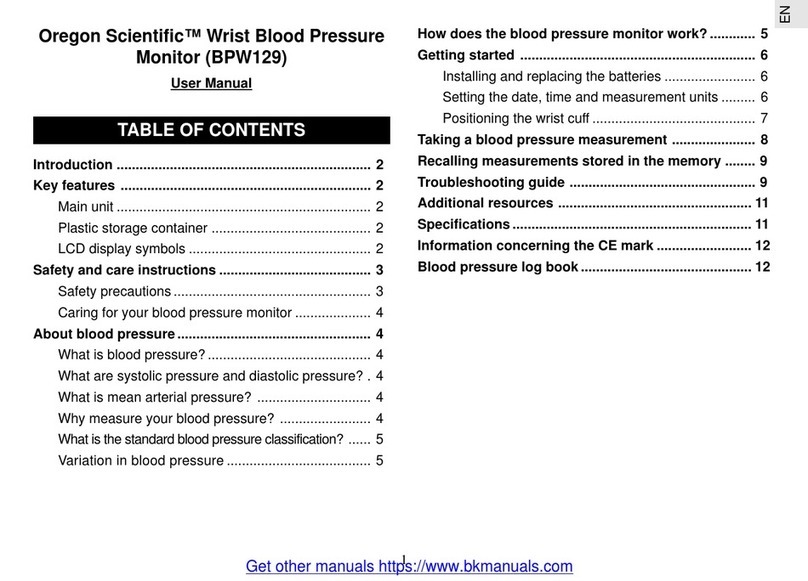
Oregon Scientific
Oregon Scientific BPW129 User manual
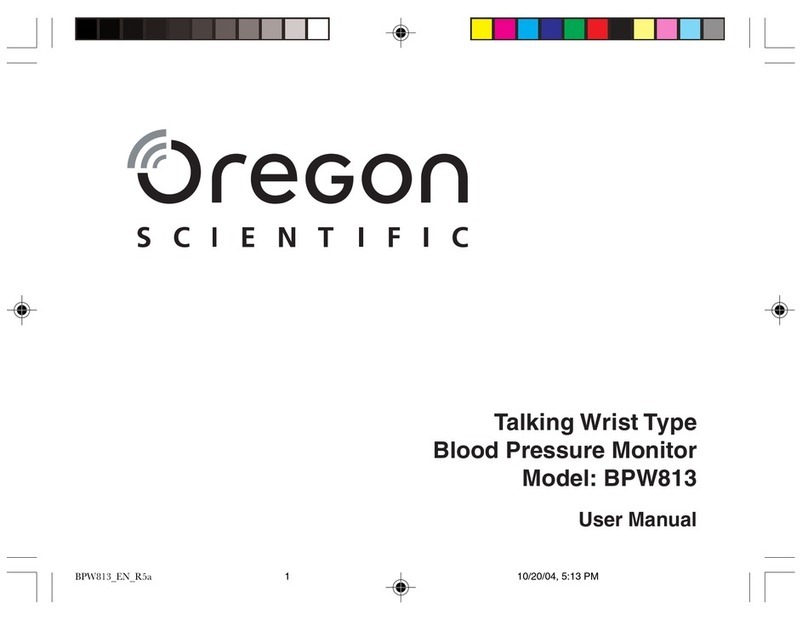
Oregon Scientific
Oregon Scientific BPW813 User manual

Oregon Scientific
Oregon Scientific BPW120 User manual
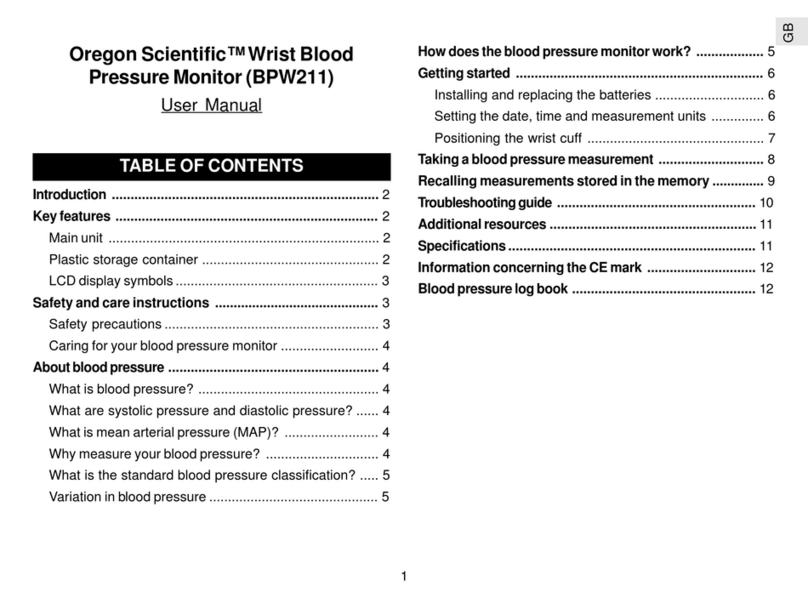
Oregon Scientific
Oregon Scientific BPW211 User manual
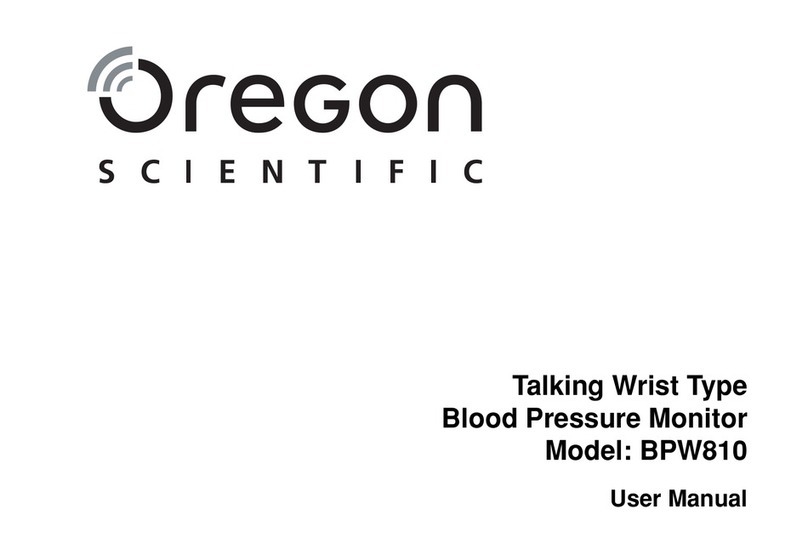
Oregon Scientific
Oregon Scientific BPW810 User manual
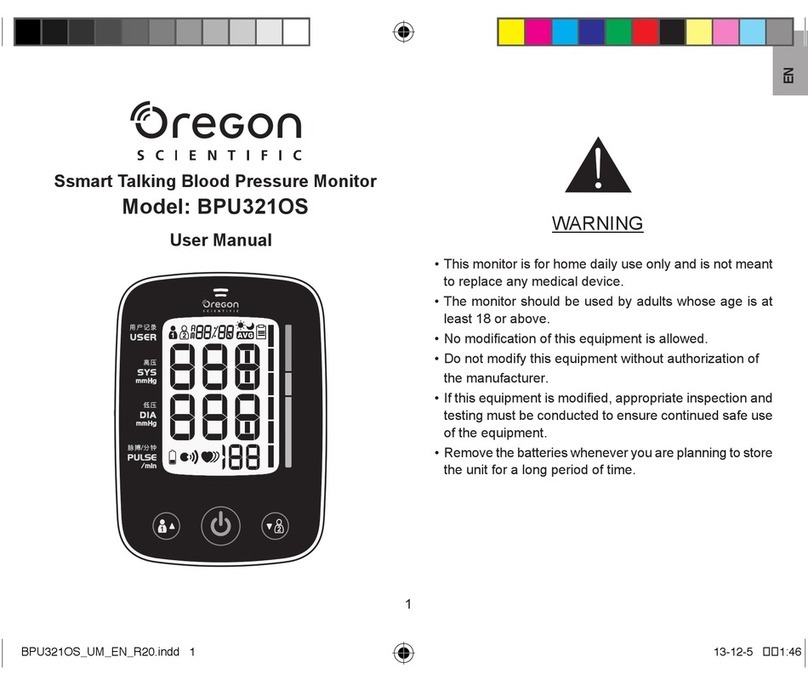
Oregon Scientific
Oregon Scientific BPU321OS User manual
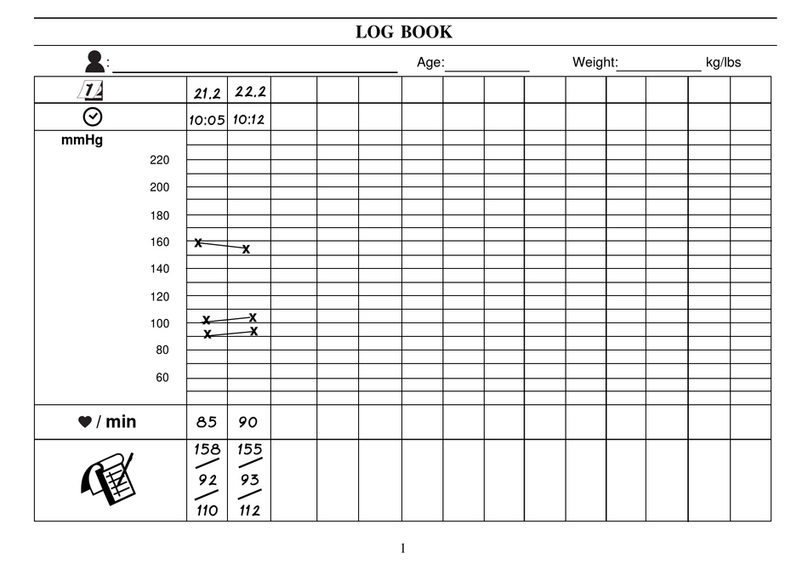
Oregon Scientific
Oregon Scientific BPW128 User manual

Oregon Scientific
Oregon Scientific BPW120 User manual


